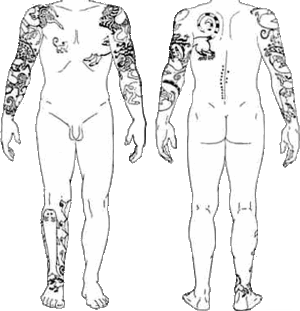Scythian Chieftain
The Scythian Chieftain is a wonderfully-preserved individual discovered in a tomb south of Kiev, in 1947. Like the Pazyryk finds, the body had remained relatively intact through a combination of deliberate embalming and the freezing temperatures of the region. The Scythians were culturally related to the Pazyryk, a connection seen most obviously in the decorative animal motifs which both tribes have in common. The chieftain was extensively tattooed, with zoomorphic designs covering his shoulders, arms, his lower right leg, and parts of his chest and back.
He also had two rows of dots tattooed down his spine, an unusually simple motif compared to his other tattoos. It is possible that, as with Ötzi (The Iceman), these could have been applied for therapeutic purposes.
A felt cutout depicting a ram was found in the tomb along with many other grave goods. This seemingly insignificant item was later shown to be identical to a ram on the chieftain's right arm. It is believed that the cutout would have been used as a stencil; the felt would be soaked in dye and placed on the skin, leaving a stain in the exact shape of the cutout.
The Scythians were a nomadic group indigenous to what is now Siberia. Renowned for their creativity, the Scythians were a race also notorious for their cruelty. Herodotus, the Greek historian, devoted half a volume of his History to the Scythians, describing them as evil red-haired barbarians who scalped their enemies, and who measured courage by the number of scalps taken (as an interesting sidenote, one of the Pazyryk mummies was scalped and his skull crushed).
